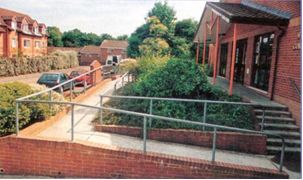ACCESS TO / USE OF BUILDINGS & THE DISABILITY DISCRIMINATION ACT
| An important and developing function of Building Control is to ensure that all new buildings are provided with adequate access and facilities for persons with disabilities. The aim is to provide a suitable means of access for disabled people from car parking which is provided within the building site to the point of entrance to the building. |  |
Wheelchair users and ambulant disabled people have difficulty in negotiating changes of levels and people with impaired sight may be unaware of the onset of abrupt changes in level. It is therefore desirable that the principal access to the building has a level approach; if this is not possible then a ramped approach can be used. As the needs of disabled people vary, alternative means of access are helpful. Not all ambulant disabled people find it as easy to negotiate a ramp as they do a stair, therefore a stepped approach can be incorporated.
In addition to access requirements, other facilities need to be considered, such as sanitary conveniences, which should be no less available for disabled people than for able-bodied people.
It should be noted that many of the aims of the Building Regulations (Part M) are similar to those of the Disability Discrimination Act 1995 (DDA). The DDA imposes, amongst other things, a duty on service providers to make reasonable adjustments to premises to avoid discrimination against people with disabilities. This applies to existing buildings as well as new premises from 1st October 2004, but is not enforceable under Building Control legislation. Further information on the requirements of the DDA is available from our list of useful contacts.
For further technical advice in connection with Part M please click here or contact Building Control. A ‘guidance note’ is also available for your assistance.
Page last updated on: 22/08/2012





